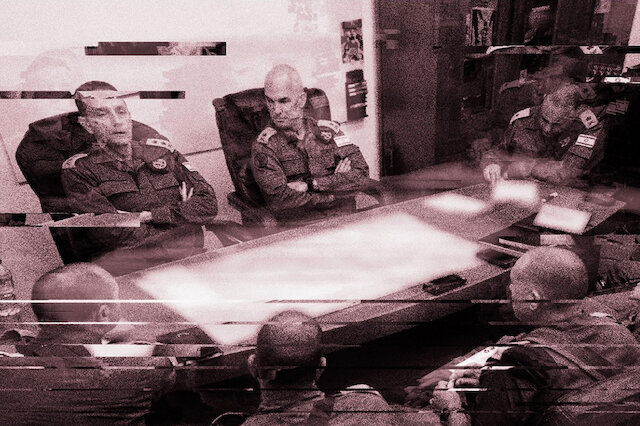Jabalia: A quagmire for “generals”

In early October, following the Israeli regime’s attack on Lebanon, it also began operations in northern Gaza, particularly in the Jabalia camp. For the first time since the war began, the Israeli regime referred to Gaza as the “second front” in the conflict, indicating that the Israeli army lacks the resources to control a ground operation in Gaza without resorting to inhumane and disastrous methods. This shortage of resources and the army’s decline appear to have prompted some veteran Israeli generals, including Giora Eiland, to develop a chilling military plan for attacking northern Gaza.
Known as the Generals’ Plan, this strategy involves ordering the complete evacuation of northern Gaza’s civilian population, shutting down all routes for humanitarian aid — such as food, medicine, and water — and ultimately waiting for the Resistance members in the area to be exhausted or killed. The plan’s designers argue that it complies with international law and has historical precedents in other conflicts, but it has faced significant challenges in Gaza.
First, just a few days after the evacuation order was issued for these areas, news outlets reported that the people in northern Gaza were ignoring the directive and choosing to stay. For someone who hasn’t been following the war from the start, it might seem like a mistake on the part of the civilians, which could absolve the Israeli regime of responsibility. However, for those who have been following the news, even sporadically, the reaction of the people in northern Gaza is entirely understandable. Over the past year, the Israeli regime has repeatedly issued evacuation orders for various areas of Gaza, only to bomb the routes people used to reach the so-called safe zones. Eventually, after survivors took shelter in schools, around hospitals, and in refugee camps, those locations were also targeted.
In reality, the people of northern Gaza have not made a reckless choice. They’ve simply decided to stay in their homes instead of facing the alternative of dying in a refugee camp, choosing to defend their dignity at all costs .The Resistance in Gaza also has deep roots in this region. Neighborhoods like Shuja’iyya, Jabalia, and Beit Lahia have long been known for producing Resistance fighters, even before the Al-Aqsa Flood began. For nearly a month, since the start of that conflict, the Israeli regime was committing significant military resources to gain control of Beit Lahia, suffering heavy losses in the process. Then they focused on Shuja’iyya, where the Resistance inflicted major casualties on the Golani Brigade, contributing to their withdrawal from the fighting .The Resistance in Jabalia has frustrated the Israelis so much that they began heavy bombings in that area early in the war, resulting in horrific scenes. Despite these efforts, Israeli forces have been unable to eliminate the Resistance in northern Gaza or establish a solid presence there. In the last two weeks, the Al-Qassam Brigades have carried out daring ambushes, causing significant casualties to the Israeli army, while the regime continues to censor its reported military losses in Gaza. Almost daily, the Resistance posts videos of direct hits from rockets, bullets, or explosions near gatherings of Israeli soldiers, while Israeli reports usually mention only one or two casualties in Gaza.
The Israelis have implemented this plan with a specific goal in mind. Giora Eiland mentioned in a meeting with the Knesset’s Foreign Affairs and Defense Committee, “I prefer that within a year, the situation in all of northern Gaza reaches a point where we can call it occupied territory.”
Reports from Jabalia indicate that this initiative has been ongoing for over two weeks. During this time, routes for humanitarian aid, water pumps, and medical supplies have been blocked, while the regime has carried out continuous bombardments, resulting in a massacre of the people. This shows that the Generals’ Plan is in motion, and contrary to earlier statements from Israeli officials, they now aim to ethnically cleanse northern Gaza, turning it into an uninhabitable area for permanent occupation.
In his Friday prayers speech in Tehran, following the martyrdom of Sayyid Hassan Nasrallah, Imam Khamenei spoke about the West’s long-term plan to make the Israeli regime a hub for regional trade. This plan could not succeed without the regime controlling a vital coastal area like Gaza. Therefore, Abu Obeida, spokesman for the Al-Qassam Brigades, made particularly relevant comments during the anniversary of the Al-Aqsa Flood:
During that event, we dealt a significant preemptive blow to the enemy after their plans for a major assault on the Resistance in Gaza were nearing completion, following their unprecedented and dangerous attacks on Al-Aqsa Mosque, their deep involvement in settlement expansion and Judaization, and their brutal actions against prisoners while ignoring all sanctities and completely besieging the Gaza Strip. In light of all this, the decision was made to launch a strategic and historic attack against the Israeli army’s forces in Gaza, its military bases, and its notorious settlements, which has cast a heavy shadow over our families.
The resistance of the Palestinian people today in northern Gaza has led to voices within the regime recognizing the inevitable failure of the Generals’ Plan. Continuing this resistance will, by God’s will, secure the eventual victory of the Palestinian people in this ongoing conflict, and Jabalia will turn into a quagmire for the generals.
| © | KHAMENEI.IR |


